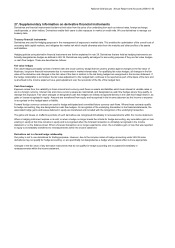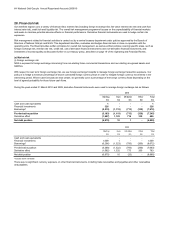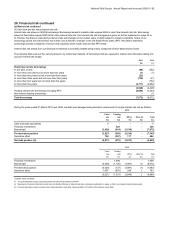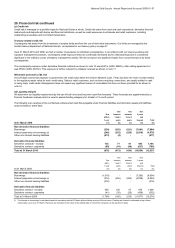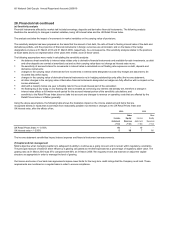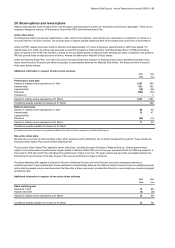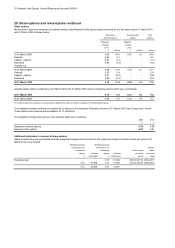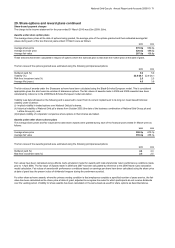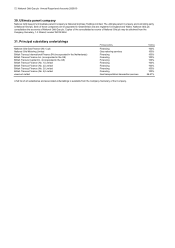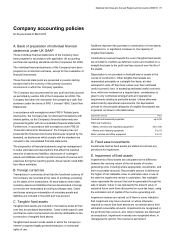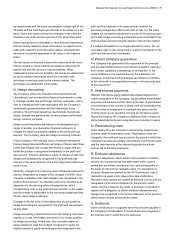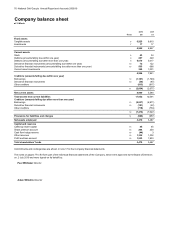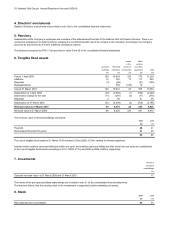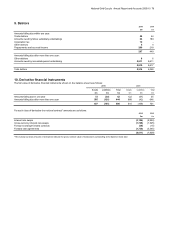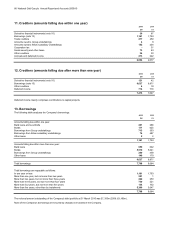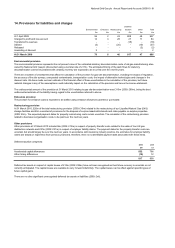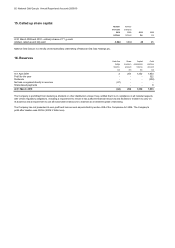National Grid 2010 Annual Report Download - page 75
Download and view the complete annual report
Please find page 75 of the 2010 National Grid annual report below. You can navigate through the pages in the report by either clicking on the pages listed below, or by using the keyword search tool below to find specific information within the annual report.
National Grid Gas plc Annual Report and Accounts 2009/10 73
Company accounting policies
for the year ended 31 March 2010
A. Basis of preparation of individual financial
statements under UK GAAP
These individual financial statements of the Company have
been prepared in accordance with applicable UK accounting
and financial reporting standards and the Companies Act 2006.
The individual financial statements of the Company have been
prepared on a historical cost basis, except for the revaluation of
financial instruments.
These financial statements are presented in pounds sterling
because that is the currency of the primary economic
environment in which the Company operates.
The Company has not presented its own profit and loss account
as permitted by section 408 of the Companies Act 2006. The
Company has taken the exemption from preparing a cash flow
statement under the terms of FRS 1 (revised 1996) ‘Cash Flow
Statements’.
In accordance with exemptions under FRS 8 ‘Related party
disclosures’, the Company has not disclosed transactions with
related parties, as the Company’s financial statements are
presented together with its consolidated financial statements.
Furthermore, in accordance with exemptions under FRS 29
‘Financial Instruments: Disclosures’, the Company has not
presented the financial instruments disclosures required by the
standard, as disclosures which comply with the standard are
included in the consolidated financial statements.
The preparation of financial statements requires management
to make estimates and assumptions that affect the reported
amounts of assets and liabilities, disclosures of contingent
assets and liabilities and the reported amounts of revenue and
expenses during the reporting period. Actual results could differ
from these estimates.
B. Foreign currencies
Transactions in currencies other than the functional currency of
the Company are recorded at the rates of exchange prevailing
on the dates of the transactions. At each balance sheet date,
monetary assets and liabilities that are denominated in foreign
currencies are retranslated at closing exchange rates. Gains
and losses arising on retranslation of monetary assets and
liabilities are included in the profit and loss account.
C. Tangible fixed assets
Tangible fixed assets are included in the balance sheet at their
cost less accumulated depreciation. Costs include payroll costs
and finance costs incurred which are directly attributable to the
construction of tangible fixed assets.
Tangible fixed assets include assets in which the Company’s
interest comprises legally protected statutory or contractual
rights of use.
Additions represent the purchase or construction of new assets,
extensions to, or significant increases in, the capacity of
tangible fixed assets.
Contributions received towards the cost of tangible fixed assets
are included in creditors as deferred income and credited on a
straight-line basis to the profit and loss account over the life of
the assets.
Depreciation is not provided on freehold land or assets in the
course of construction. Other tangible fixed assets are
depreciated principally on a straight-line basis, at rates
estimated to write off their book values over their estimated
useful economic lives. In assessing estimated useful economic
lives, which are reviewed on a regular basis, consideration is
given to any contractual arrangements and operational
requirements relating to particular assets. Unless otherwise
determined by operational requirements, the depreciation
periods for the principal categories of tangible fixed assets are,
in general, as shown in the table below:
Depreciation periods Years
Freehold and leasehold properties up to 50
Plant and machinery:
– Mains, services and regulating equipment 30 to 100
– Meters and metering equipment 5 to 18
Motor vehicles and office equipment 3 to 10
D. Fixed asset investments
Investments held as fixed assets are stated at cost less any
provisions for impairment.
E. Impairment of fixed assets
Impairments of fixed assets are calculated as the difference
between the carrying values of the net assets of income
generating units, including where appropriate, investments, and
their recoverable amounts. Recoverable amount is defined as
the higher of net realisable value or estimated value in use at
the date the impairment review is undertaken. Net realisable
value represents the amount that can be generated through the
sale of assets. Value in use represents the present value of
expected future cash flows discounted on a pre-tax basis, using
the estimated cost of capital of the income generating unit.
Impairment reviews are carried out if there is some indication
that impairment may have occurred, or where otherwise
required to ensure that fixed assets are not carried above their
estimated recoverable amounts. Impairments are recognised in
the profit and loss account, and, where material, are disclosed
as exceptional. Impairment reversals are recognised when, in
management’s opinion, the reversal is permanent.


